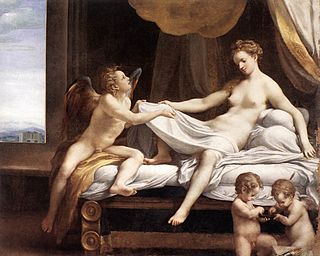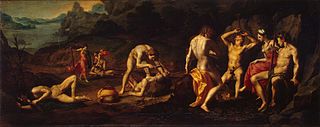 W
WThe Allegory of Vice is an oil on canvas painting by Correggio dating to around 1531 and measuring 149 by 88 cm. It and Allegory of Virtue were painted as a pair for the studiolo of Isabella d'Este, with Vice probably the second of the two to be completed. This hypothesis is since only one sketch survives for Vice, unlike Virtue, for which several preparatory studies survive, along with a near-complete under-drawing – this suggests Correggio had become more proficient after the difficult gestation of Virtue.
 W
WThe Allegory of Virtue is an oil on canvas painting by Correggio dating to around 1531 and measuring 149 by 88 cm. It and Allegory of Vice were painted as a pair for the studiolo of Isabella d'Este, with Vice probably the second of the two to be completed. This hypothesis is since only one sketch survives for Vice, unlike Virtue, for which two preparatory studies survive, along with a near-complete oil sketch - this suggests Correggio had become more proficient after the difficult gestation of Virtue.
 W
WDanaë is a painting by the Italian Renaissance artist Correggio, executed around 1531 and now in the Galleria Borghese in Rome.
 W
WFlaying of Marsyas is a 1531 painting by the Florentine artist Bronzino, depicting the flaying of Marsyas by Apollo after the satyr rashly challenged the Greek god to a musical contest. It is held in the Hermitage Museum.
 W
WHercules and Antaeus is a 1531 oil painting by the German artist Hans Baldung. It was donated in 1892 by Edward Habich to the Gemäldegalerie Alte Meister (Kassel) in Germany, where it still hangs.
 W
WLeda and the Swan is an oil on canvas painting from 1530–31 by the Italian painter Correggio, now in the Gemäldegalerie in Berlin. It shows three scenes of Leda's seduction by Jupiter who has taken the form of a swan. Their first meeting is shown on the right hand side and their lovemaking in the centre, where Leda sits with the swan between her thighs, guiding him with her left hand. They are accompanied to their left by Cupid with his bow and two cupids with flutes. The third scene is the swan flying away whilst Leda gets dressed. Leda and the Swan was a common subject in 16th-century art.
 W
WThe Penitent Magdalene is a painting of saint Mary Magdalene by Titian dating to around 1531, signed 'TITIANUS' on the ointment jar to the left. It is now in the Sala di Apollo of the Palazzo Pitti in Florence, Italy.
 W
WSaint Jerome in Penitence or Penitent Saint Jerome is a c.1531 oil on canvas painting Titian, now in the Louvre in Paris.